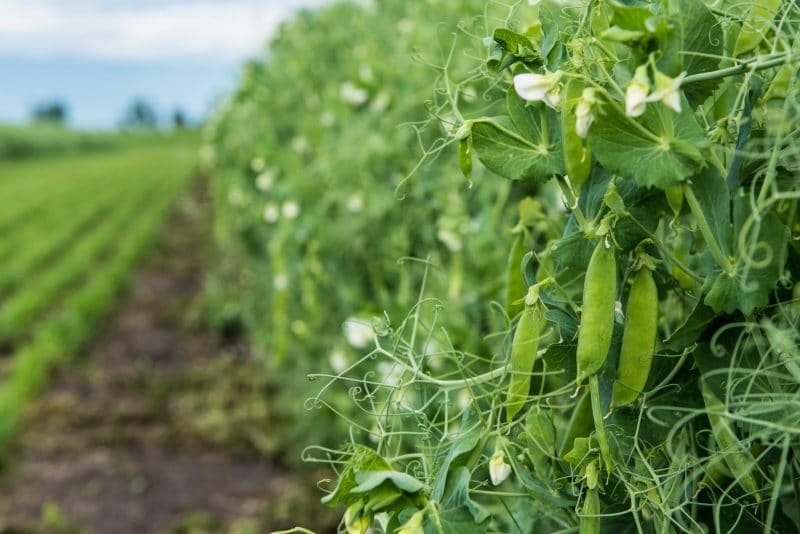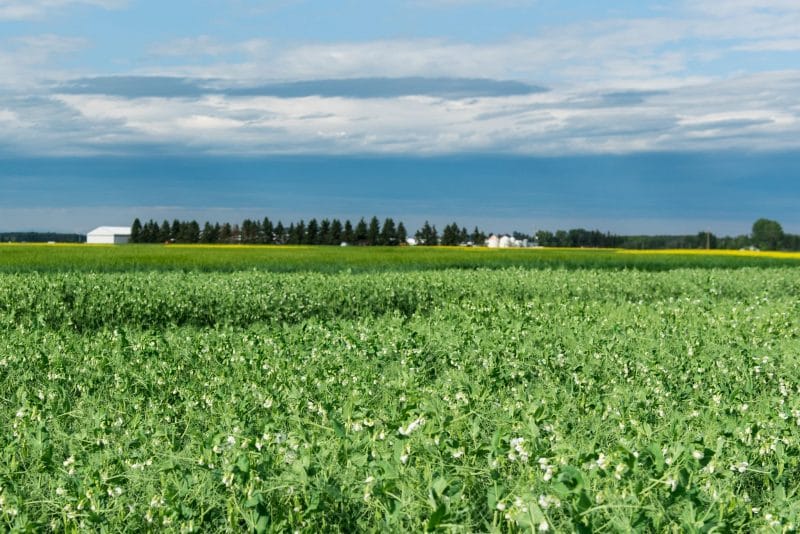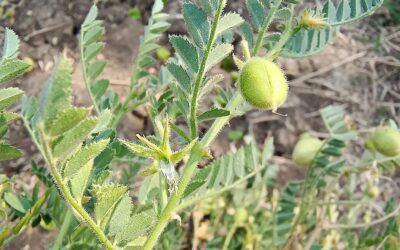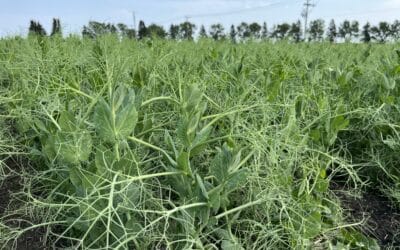According to Robyne Bowness Davidson, a pulse research scientist at Alberta Agriculture and Forestry (AF) in Lacombe, Alta., there is huge opportunity for the pulse industry due to demand for plant-based protein.
“By 2050, the global demand for food is expected to rise significantly, and with it, the shift to include more protein in diets, especially in Asia. Add to that, the shift in consumer trends toward more plant-based protein and the demand to grow food more sustainably.”
Bowness Davidson notes the new Canada Food Guide recommends Canadians eat more plant protein and many major restaurants are now providing vegan options. Over the next five years, she says, human consumption of plant-based protein is expected to double — and there is also a huge increase in demand for protein to make pet food, livestock feed and aquaculture feed.
The agriculture sector in Western Canada is very well-positioned to meet these demands.
“We already know how to grow pulses well, and as more and more fractionation plants are announced, we, as an industry, will be able to add more value to our products by processing them here,” says Bowness Davidson. “By separating pulses into the fibre, starch and protein that the companies are requesting, we increase our marketability. This creates jobs, grows our Canadian businesses and strengthens our economy, while still building our large international export markets.”
In terms of pulse breeding, various high-protein lines are being developed by AF’s breeding partners, which include universities, Agriculture and Agri-Food Canada (AAFC) and private breeding companies in Canada and in several European countries. Once new lines are genetically stable, Mark Olson (unit head of crops at AF), Christy Hoy (research agrologist, AF) and their colleagues test them under Alberta growing conditions through the project “Enhancing Field Pea, Faba Bean and Lentil Productivity and Resilience through Germplasm Screening” funded by the Alberta Pulse Growers (APG). Promising lines are entered into the Western Co-op trials (also known as registration trials), which are funded by industry and government.
“The success of pulse breeding and projects like the one mentioned above continues to speak for itself as yields have continued to grow at one to two per cent per annum,” says Olson. “However, while pulses are recognized for numerous benefits, such as being high in protein, low in fat, and for their ability to fix nitrogen [lowering the carbon footprint of the entire cropping system], they are not one of the top six economically most important crops [rice, wheat, soybean, cotton, corn/maize and vegetables] globally.”
Large, international companies are not investing billions of dollars in pulse breeding in the Prairies, says Olson, as is currently happening in the pursuit of hybrid wheat, soybean and grain corn. “Public breeding institutions are heavily relied upon in pulse breeding and this will not be changing in the near future,” he explains. “That said, for pulse crops, public-private collaboration is absolutely critical.”
Genetics are only one factor in boosting pulse protein content, says Olson. He explains field pea protein content is affected by environment, soil type and agronomic management practices, and research has shown even genetically-identical dry pea plants grown in the same year and on the same field produced protein concentrations that ranged from 19.3 to 25.2 per cent. Protein content is also affected by inoculation and fertilizer application.
That’s why AF is also working with Alberta Pulse Growers (Zone 3) to determine which agronomic practices — for example, adding nitrogen — best boost pulse protein. Olson explains while it may seem counter-intuitive to add nitrogen to pulse crops because they fix their own nitrogen, timing N application at anthesis in other crops, such as cereals, does usually increase grain protein.
Therefore Olson, Hoy, Bowness Davidson and their colleagues are examining application of the following to Amarillo peas: foliar N (15 pounds per acre and 30 lbs/ac actual N), peat inoculant (1X, 2X, 3X rates), commercial products such as Releaf/42PHI, Foliar Nitrogen/Sulphur applications, ESN, a slow-release coated N (15 lbs/acre actual), urea N (30lbs/acre actual) at seeding, granular inoculant (1X rate), inoculant blend (peat and granular) and commercial products (Magnetar liquid, Magnetar All Out). In addition, a high-protein field pea line developed by D.J. Bing (Agriculture and Agri-Food Canada) was also included as a treatment in the research trial.
Efforts to investigate how growing regions across Western Canada and crop management practices impact protein and starch attributes of pulses are also being undertaken by Pulse Canada, Manitoba Pulse and Soybean Growers and Saskatchewan Pulse Growers.

Over the next five years, human consumption of plant-based protein is expected to double, says Robyne Bowness Davidson, an Alberta Agriculture and Forestry pulse research scientist. (Photo: Rob Mcmorris Photography)
More breeding goals
Pulse Canada has set a goal for 25 per cent of Canada’s pulse production to be sold in “new use categories” such as food ingredients by 2025, and as a member of Pulse Canada, APG shares this goal. APG research manager, Jenn Walker, in a new article for APG’s Pulse Crop News, reportsexpandingthe value and usage of pulse crops by having targeted end uses for the starch, fibre and protein components in addition to the traditional markets for whole seed, could push demand for western Canadian pea, lentil, chickpea, faba bean and dry bean crops to new heights.
“The challenge, however, is to ensure the pulses Canadian farmers grow are bred to provide the precise qualities food companies are looking for, and to ensure they are both functional in the food manufacturing process and that they taste good,” says Walker.
Related to Bing’s research — he is testing high protein lines of 28 to 30 per cent protein in a variety of locations in Alberta to ensure varieties will deliver acceptable yields — is that conducted by Jay Han, senior food scientist with AF’s Food Processing Development Centre, says Walker. Han is focused on achieving a milder pea flavour and tailoring pea characteristics to address processors’ desires, and he is working with various processors on this.
Also, according to Walker, Lingyun Chen, professor and Canada research chair in the Faculty of Agricultural Life and Environmental Sciences at the University of Alberta, is carrying out research funded by APG to examine value-added applications for pulse proteins (pea, lentil and faba beans) in human foods. Chen notes that processors are focused on getting high protein yields from the extraction process, but she is also investigating how processing can change pulse protein structure and how this can be optimized to ensure processors are getting desired structural characteristics.

William Pellinger, a pulse breeder with Limagrain (UK) Ltd., visually evaluates the performance of the company’s varieties in Canada. (Photo: Rob Mcmorris Photography)
Another researcher in the pulse protein sphere identified by Walker is U of A professor Thava Vasanthan, who developed cost-effective Air Currents-Assisted Particle Separation (ACAPS) technology several years ago.
“Vasanthan believes that as the fractionation is refined and the manufacturing process improved, pulse crops stand a good chance of growing their footprint in the multi-billion-dollar North American pet food market,” says Walker. “Over the past year and a half, he has started characterization of pulse crops for this market. Because high fibre and high starch levels are not desirable in pet food, processing to minimize these components and maximize the bioavailability of the protein through cost-efficient technologies is critical.” Vasanthan’s research is supported by funding from APG.
Walker concludes that while the protein content of pea crops isn’t currently increasing sale prices for farmers, strong demand for pulse ingredients in human and pet food could very well see them increase in future. “Understanding what to grow where for specific end-markets may soon provide farmers with closed loop contract opportunities, and grower organizations want to be sure that we have the agronomic knowledge to support consistent supply of highly-desired product.”
APG chair, Don Shepert, believes there is a lot of potential for growers to be rewarded for choosing to grow peas or lentils with specific quality attributes for specific companies, but adds that, “yield and disease resistance will always be key to breeding programs that are focused on the whole seed markets where farmers get paid based on tonnage of product.”
He also says that while changes to grading systems are often a point of discussion, until there are clear guidelines on the needs of specialty markets, it will be difficult to put new grading parameters in place.





